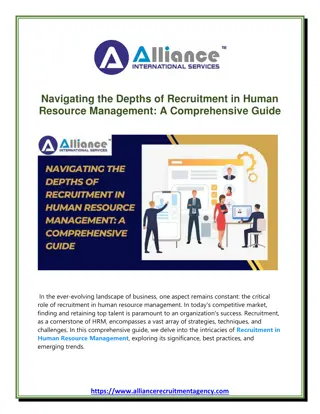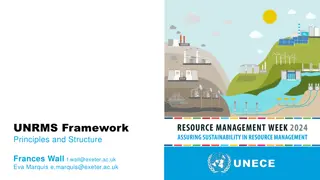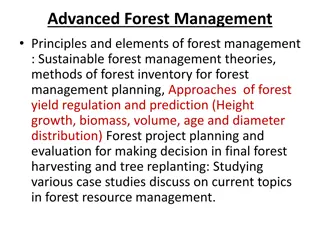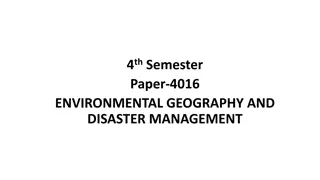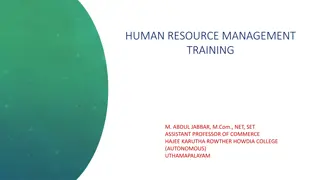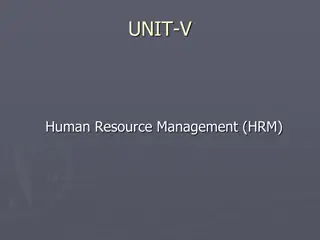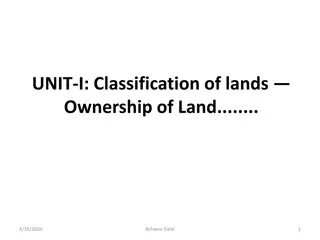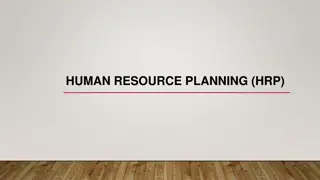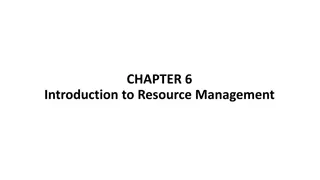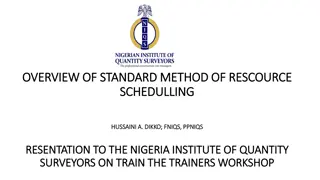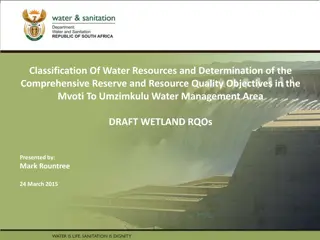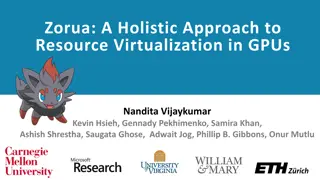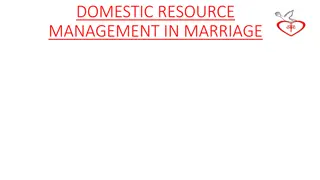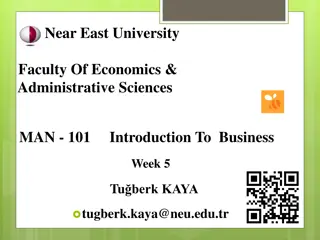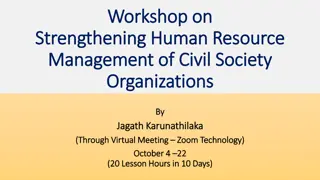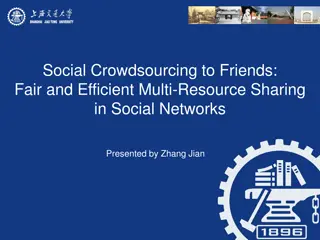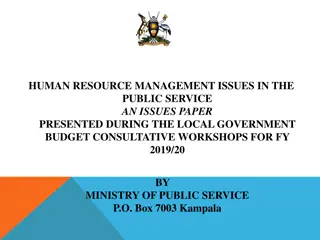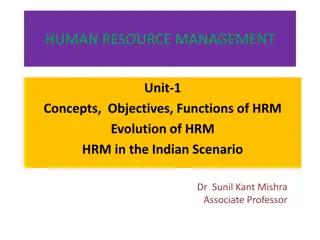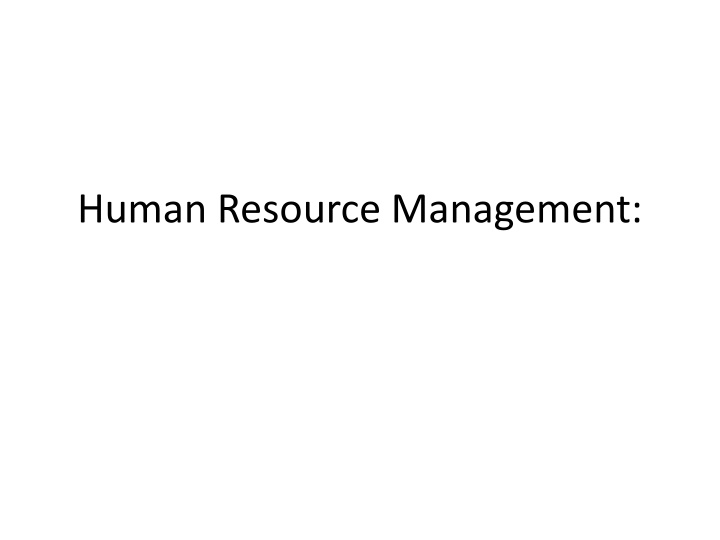
Human Resource Management in Organizations
Human Resource Management (HRM) is vital for organizations to effectively utilize human talent and achieve goals. This includes activities like attracting, developing, and retaining a skilled workforce. The importance, policies, goals, and roles of HRM are discussed, highlighting its strategic and operational aspects compared to personnel management.
Download Presentation

Please find below an Image/Link to download the presentation.
The content on the website is provided AS IS for your information and personal use only. It may not be sold, licensed, or shared on other websites without obtaining consent from the author. If you encounter any issues during the download, it is possible that the publisher has removed the file from their server.
You are allowed to download the files provided on this website for personal or commercial use, subject to the condition that they are used lawfully. All files are the property of their respective owners.
The content on the website is provided AS IS for your information and personal use only. It may not be sold, licensed, or shared on other websites without obtaining consent from the author.
E N D
Presentation Transcript
Introduction If you are planning for one year, plant rice; if you are planning for ten years, plant fruit- trees; but if you are planning for a hundred years, plant men. Chinese Proverb What is Human Resource Management? Human Resource Management (HRM) is the design of formal systems in an organization to ensure the effective and efficient use of human talent to accomplish organizational goals. HRM is also seen as the set of organizational activities directed at attracting, developing, and maintaining an effective workforce. 1
The Importance of Human Resource Management Why is human resource management important to all managers? Dessler It is easier to answer this question by listing some of what a manager would want while managing. For example, he would want to: Hire the right person for the job. Experience a low turnover. Find his people doing their best. Save time. Reduce the incidence of litigation because of discriminatory actions. Have the company cited under federal laws for safe practices. Have the employees think their salaries are fair and equitable relative to others salaries in the organization. Allow training to enhance the department s effectiveness. Fair labour practices. Secure competitive advantage 2
Human Resource Management Policies: Basis and Principles Contemporary scholars interested in HR management base their principles of policies on the teachings of the human relations school as follows: All employees should be treated with justice. The needs of employees must be recognised, particularly their desires for job satisfaction, for knowledge of what is going on within the organisation, A business will function better democratically 3
The Goals of Human Resource Management The goals of HR management are to develop the workers in the organization to contribute to goal achievement in the organization by management for improved: productivity, Quality, and service. 4
The Role of Human Resource Management Strategic Role Operational Role 5
Personnel Management and HRM: A graphic Comparism. Personnel Management HR Management HR fundamentally linked to the corporate plan activity in the organization Personnel activity in the organization is marginalized and not seen as central to the corporate plan Few personnel directors on the board An HR director is essential on the board Personnel as a mediating role between management and the workforce HR management as a central management role Emphasis on written rules and procedures Flexibility more important than systems Collective rewards and benefits Individual rewards and benefits Tightly defined jobs Loosely defined jobs Conflict built into the system by collective bargaining and negotiation Conflict minimized through consultation and participation A command and control management hierarchy A team-based management system 6
Human Resource Management Functions and the Environment The activities and Functions are: HR planning and analysis Equal employment opportunity Staffing HR development Compensation and benefits Employee and labour/management relations 7
What is Human Resource Development? Staff development is the process whereby an employee is enabled to grow in the job, through the acquisition of wide experience, breadth and increasing confidence resulting from the exercise of varied and tested responsibilities, the aim being to enable him to reach the top or achieve his best in his profession of employment. Activities related to human resource development are as follows: Orientation Training Employee Development Career planning Performance appraisal 8
Human Resource Development System Human Resources Development System is: A set of integrated processes for ensuring the ongoing development of highly productive, dedicated and motivated employees Aligned with business strategies. Designed to facilitate achievement of desired & organizational goals. Performance Assessment & Development Recruiting & Orientation Training & Education Employee Development System Business Strategy Results Supporting Policies Compensator Staffing & Position Planning 9
The Strategic Challenges of HRM in Nigeria Changes in the Economy Influence of Technology Challenges of Workplace Diversity Chain of Command Organisational Changes Market Dynamics Globalization, Outsourcing, and Offshoring 10
The Changing Role of Human Resource Management Business Partner Change Agent Human Resources Employee Advocate Administrative E4xpert From the above model HR managers perform the following new roles: (a) As a Strategic Partner (b) As an Employee Advocate (c) As a Change Agent (d) As an administrative expert 11
Moving Forward Contemporary HRM mind the following in order to move forward. Encouraging reputation management and corporate ethics: Utilizing the advantages of diversity of workforce: Embolden control and result measurement Enhancing flexibility and creativity Other Options Human resource managers should also consider these salient options: Use workforce skills and abilities in order to exploit environmental opportunities and neutralize threats. Employ innovative reward plans that recognize employee contributions and grant enhancements. Indulge in continuous quality improvement through TQM and HR contributions like training, development, counseling, etc Utilize people with distinctive capabilities to create unsurpassed competence in an area. Decentralize operations and rely on self-managed teams to deliver goods in difficult times 12
Conclusion The role of human resource management in recent times has witnessed so many changes. This is as a result of so many issues and challenges being faced by human resource managers in contemporary organizations. The economic situation which has led to the withdrawal of some employees and the effects of political instability all contribute to this changing role. Human resource managers can overcome these challenges if they are more proactive are given favourable consideration and if HRM is accorded its right place in organisations in Nigeria. 13


